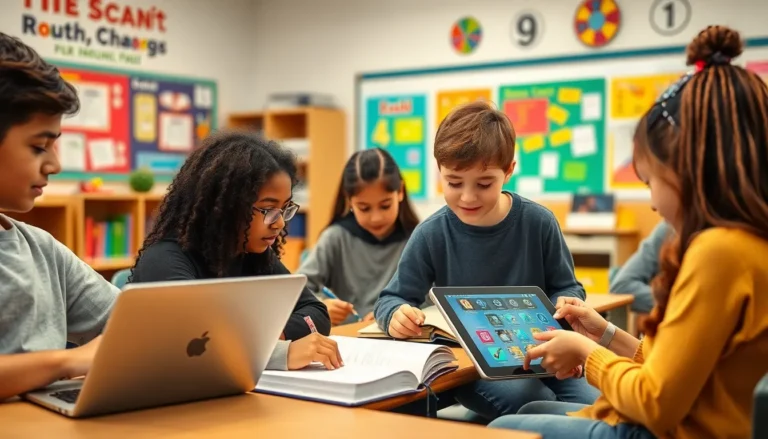In a world where kids can learn to code before they can tie their shoes, technology for homeschooling has become the superhero parents didn’t know they needed. Forget the days of dusty textbooks and endless worksheets; today’s digital tools make learning as fun as a cat video binge. With a few clicks, students can explore the universe, dissect a frog, or even learn a new language—all from the comfort of their living rooms.
Table of Contents
ToggleOverview Of Technology For Homeschooling
Technology significantly enhances the homeschooling experience by providing diverse resources. Digital platforms offer interactive lessons, enabling students to engage with subjects in a more meaningful way. Online courses deliver structured materials created by experts, allowing for subject-specific focus. Various educational apps support skill development through fun, gamified experiences that keep learners motivated.
Video conferencing tools facilitate live discussions and collaboration between students and teachers, enriching the learning environment. Virtual reality creates immersive experiences that can transport students to historical events or scientific phenomena, making lessons memorable.
Learning management systems organize coursework and track progress, providing both parents and students with visibility into educational journeys. E-books and audiobooks replace traditional texts, offering convenience and accessibility for different learning preferences.
Moreover, many online communities and forums allow parents to connect with one another, sharing tips and resources that can enhance their homeschooling experience. Social media platforms also provide access to educational content and networks, fostering collaboration among homeschooling families.
Data shows that the integration of these technologies leads to improved academic outcomes. Research indicates that 70% of homeschooling parents report enhanced learning experiences due to technology usage. Considering these advantages, technology serves as an essential tool in modern homeschooling environments, enabling personalized education tailored to each child’s needs.
Benefits Of Technology In Homeschooling
Technology plays a crucial role in enhancing the homeschooling experience. Digital resources enable children to engage in personalized and interactive learning.
Enhanced Learning Experiences
Interactive tools improve student engagement and retention. Gamified educational apps motivate children to learn through play. Video conferencing allows for real-time discussions, making lessons dynamic and collaborative. Online courses offer structured, expert-developed content on various subjects, catering to different learning styles. Virtual reality creates immersive environments, letting students explore concepts firsthand, such as walking through historical sites or experiencing scientific phenomena. Data indicates that 70% of homeschooling parents note enhanced learning experiences, showcasing the positive impact of technology on education.
Flexibility And Convenience
Flexibility allows families to tailor learning around their schedules. Students can access lessons any time, facilitating learning at their own pace. Parents benefit from the convenience of choosing resources that match their children’s interests and needs. Online platforms enable quick updates to curricula, keeping learning materials current. With technology, children can explore various subjects beyond traditional limits, such as coding or foreign languages. This adaptable approach to education transforms homeschooling into a personalized journey, prioritizing each child’s unique educational path.
Types Of Technology Used In Homeschooling
Technology plays a crucial role in enriching the homeschooling experience. Various tools enhance learning and encourage engagement.
Online Learning Platforms
Online learning platforms provide structured courses covering diverse subjects. These platforms feature lessons created by experienced educators. Interactive elements promote active engagement and deeper understanding. Many families report that these platforms make learning convenient, as students can access materials at their own pace. For example, platforms like Khan Academy and Coursera offer extensive resources tailored for different age groups. Data indicates that 70% of homeschooling parents find these platforms improve their children’s learning outcomes.
Educational Apps And Software
Educational apps and software offer gamified experiences that boost skill development. These tools integrate fun with learning, keeping children motivated. Subjects like math, science, and language arts benefit from interactive activities. Popular apps, such as Duolingo for languages and Prodigy Math, engage students while addressing their individual learning styles. Increased engagement often leads to higher retention of information, confirming the significant impact of these apps. Thus, many parents embrace these technologies to enrich their children’s educational journeys.
Virtual Classrooms And Tools
Virtual classrooms and tools facilitate real-time communication between students and teachers. Video conferencing software like Zoom and Google Meet allows for live discussions, enhancing collaboration. Classroom management tools help organize lessons and track student progress. These technologies create a supportive learning environment, connecting students with peers and instructors. Reports highlight that such interactions foster a sense of community, which is vital for successful homeschooling. By integrating these tools, families can transform the learning experience into a dynamic process.
Challenges Of Using Technology For Homeschooling
Technology’s rapid integration into homeschooling presents several challenges. Parents and students face unique obstacles, which can impact the overall learning experience.
Accessibility Issues
Accessing technology remains a significant barrier for some families. Not all households possess reliable internet connections or devices, leading to disparities in educational opportunities. For instance, data indicates 15% of homeschooling families report limited access to necessary technology. Families in rural areas often struggle more than those in urban settings. Additionally, educational platforms may not accommodate all learners, particularly those with disabilities. Several tools still lack adequate adaptations for special needs students, complicating their learning journeys.
Distractions And Screen Time Management
Managing screen time poses a challenge within the home environment. Children often face numerous distractions while using technology, risking decreased focus on lessons. For example, social media and gaming can divert attention from educational tasks, making it challenging to maintain an effective study routine. Research shows that excessive screen time can lead to negative health consequences, such as eye strain and reduced physical activity. Parents must implement strategies to limit distractions and promote balanced technology use to ensure productive learning. Creating schedules and designating tech-free zones can enhance the learning environment, ensuring that education remains the primary focus.
Technology has undeniably revolutionized the homeschooling landscape. With its ability to create personalized and engaging learning experiences, it empowers children to explore subjects in depth and at their own pace. The integration of various digital tools not only enhances motivation but also fosters collaboration and community among students and educators.
While challenges like accessibility and screen time management exist, the benefits of technology in homeschooling far outweigh the drawbacks. By embracing these modern tools and implementing effective strategies, families can create a dynamic and enriching educational environment that meets each child’s unique needs. As technology continues to evolve, so too will the opportunities for homeschooling families to thrive in this digital age.


